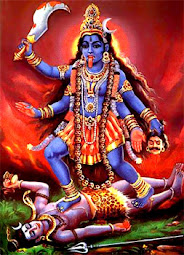Goddess Kali, one of the most revered
deities in Hinduism, holds a prominent place in Tantrism, where she embodies
the fierce and transformative aspects of the divine feminine. Known for her
dark complexion, wild hair, and a garland of skulls, Kali represents the duality of creation
and destruction, life and death.
Symbolism
and Attributes
In Tantric philosophy, Kali is often
seen as the ultimate Shakti, the primal energy that drives the cosmos. Her
fierce form symbolizes the annihilation of ignorance and the ego, making way
for spiritual awakening and liberation (moksha). She is frequently depicted
standing on the prone body of Lord Shiva, representing the union of
consciousness (Shiva) and energy (Shakti). This iconography illustrates the
balance between creation and destruction, a core principle in Tantric practice.
Kali is not only a goddess of
destruction but also of transformation. Her wrathful demeanor signifies the
removal of obstacles and impurities in the spiritual journey. Devotees believe
that by surrendering to Kali, they can overcome their fears and limitations,
ultimately attaining enlightenment.
Worship
and Rituals
In Tantrism, the worship
of Kali involves intricate rituals and practices aimed at harnessing
her powerful energies. Tantric sadhanas (spiritual practices) often include
mantras, meditation, and specific offerings to invoke her blessings. The most
common mantra associated with Kali is the "Kali Ma" mantra, which emphasizes
devotion and surrender.
Kali's worship is especially
significant during the festival of Kali Puja, celebrated with great fervor in
various parts of India. This festival involves elaborate rituals, offerings of
food and flowers, and the recitation of hymns, all aimed at pleasing the
goddess and seeking her protection and guidance.
Conclusion
Goddess
Kali in Tantrism
encapsulates the profound complexities of life, death, and spiritual
transformation. Her fierce nature serves as a reminder that true liberation
often requires confronting and overcoming one's deepest fears and attachments.
Through her worship, practitioners seek not only her blessings but also the
strength to embark on their transformative spiritual journeys, embracing the
powerful energies of creation and destruction that she embodies. Kali stands as
a potent symbol of empowerment, urging devotees to reclaim their inner strength
and embrace their true nature.
